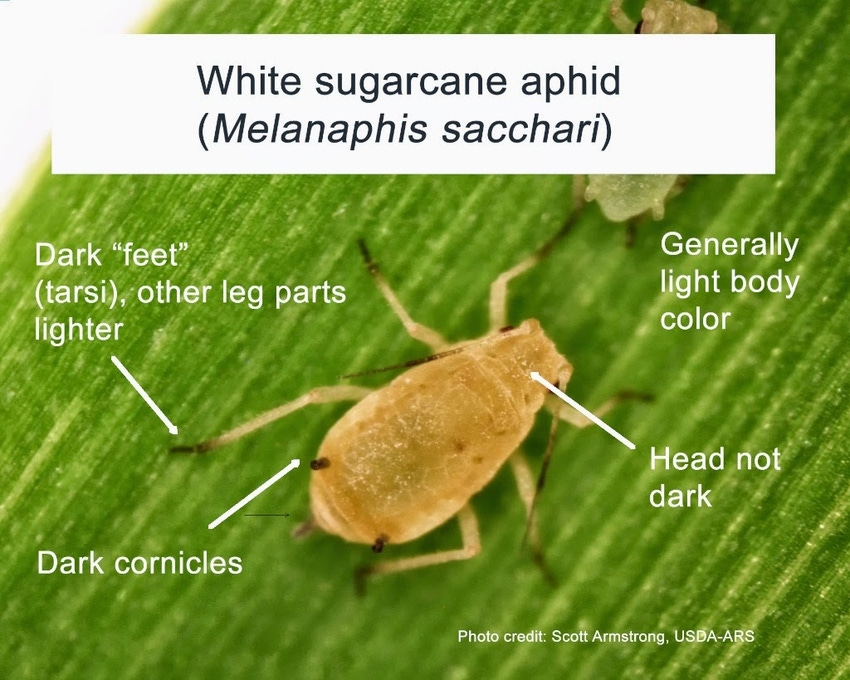
Though heavy rains and wet fields have kept many South Texas farmers out of their fields and have delayed planting of this year's massive grain sorghum crop, county agents, agricultural researchers, integrated pest management specialists, and many farmers are preparing for a major fight with the white sugarcane aphid (SCA).
Interested parties flooded into the Texas AgriLife Extension and Research Center in Corpus Christi recently for an update on the expected aphid invasion. Robert Bowling, Assistant Professor and Extension Specialist, led the workshop.
Bowling summarized the outbreak of the sugarcane aphid in grain sorghum and provided a detailed update of how aphid pressure has spread since it was first detected late in the 2013 growing season.
For the latest on southwest agriculture, please check out Southwest Farm Press Daily and receive the latest news right to your inbox.
"In late 2013 we identified this aphid for the first time primarily in Texas and Louisiana. We did have a report of a case in Mississippi and one in Oklahoma, but that was the extent of the problem at that time; we had reports covering four states and 38 counties," Bowling said. "By the end of 2014, the sugarcane aphid actually moved to surrounding sorghum production states for a total of 12 states and 340 counties."
In a single year, the aphids marched out of Texas and Louisiana and were aggressive in heading both east as far as Florida and South Carolina and north into Oklahoma, Kansas and Missouri. Sugarcane aphids were also reported in the northern High Plains of Texas near the end of the growing season last year.
In just one and-a-half growing seasons, South Texas producers suffered significantly.
Huge losses
About 45 percent of sorghum in Texas is grown on just over one million acres that stretch from the Coastal Bend to the Lower Rio Grande Valley, coastal land well suited to the crop. Entomologists report 100 percent of these sorghum acres were infested with sugarcane aphids. While 60 percent of those acres were treated, crop losses still totaled neatly 9 million bushels, a loss of about 15 percent of total production in the region. For producers, the bottom line was a $38.4 million monetary loss.
On the positive side, fields that were treated with the non-neonicotinoid insecticide Transform, a Dow AgroSciences product that was granted a limited EPA Section 18 emergency use permit for grain sorghum in 2014, improved greatly after treatment and populations reduced to safe levels or completely eliminated. But not without a cost.
South Texas farmers were paying an average of $13 an acre to treat their sorghum crop, but the added production cost was "unquestionably a profitable decision" as nearly 58 million bushels of grain sorghum were harvested over the last two seasons in spite of extreme population densities in many fields.
Scout early
If farmers do not scout early and treat fields at the appropriate time this growing season, losses are expected to be heavy. And because South Texas enjoys a sub-tropical climate, sugarcane aphids survived the winter on Johnsongrass and voluntary sorghum. These aphids will migrate to young sorghum plants not long after emergence this spring.
While the aphid is more prolific in summer, South Texas could see significant numbers by mid- to late spring, so identifying when a crop reaches a threshold of 50 to 125 aphids per leaf is critical to minimize production of thick honeydew on lower leaves. Sugarcane aphids progress up the plant and can eventually infest the head.
"There is direct and indirect damage from sugarcane aphids, the first a problem from the aphid feeding on the plant that can directly affect the overall health of sorghum," says Bowling.
Indirect damage can include heavy honeydew build-up that can cover lower leaves and gum up harvest machinery. A sooty mold also may develop on leaves and interfere with head development.
"If aphid populations build to very high numbers they could cause stress in the plant and we could even see some secondary effects like stalk rots," Bowling said.
Producers now have another insecticide option this year. The Texas Department of Agriculture and USDA were again able to secure a Section 18 emergency use permit for the use of Dow AgroSciences Transform, a Nicotinic acetylcholine receptor agonist.
Transform performed exceptionally well in South Texas sorghum fields last year and is expected to play an important control and management tool in the producer's arsenal again this year.
But also receiving a Section 18 use permit for 2015 is Bayer CropScience Sivanto that works along similar lines. Sivanto performed well in trials conducted across South Texas and other areas last year.
In addition to the workshop in Corpus Christi, another informational meeting will be held at the Texas AgriLife Research Center in Weslaco on April 14 beginning at 9 a.m. J.P. Michaud of Kansas State University and Dr. Scott Armstrong, researcher for USDA-ARS Oklahoma, will update Valley growers on continuing research on the sugarcane aphid.
About the Author(s)
You May Also Like




